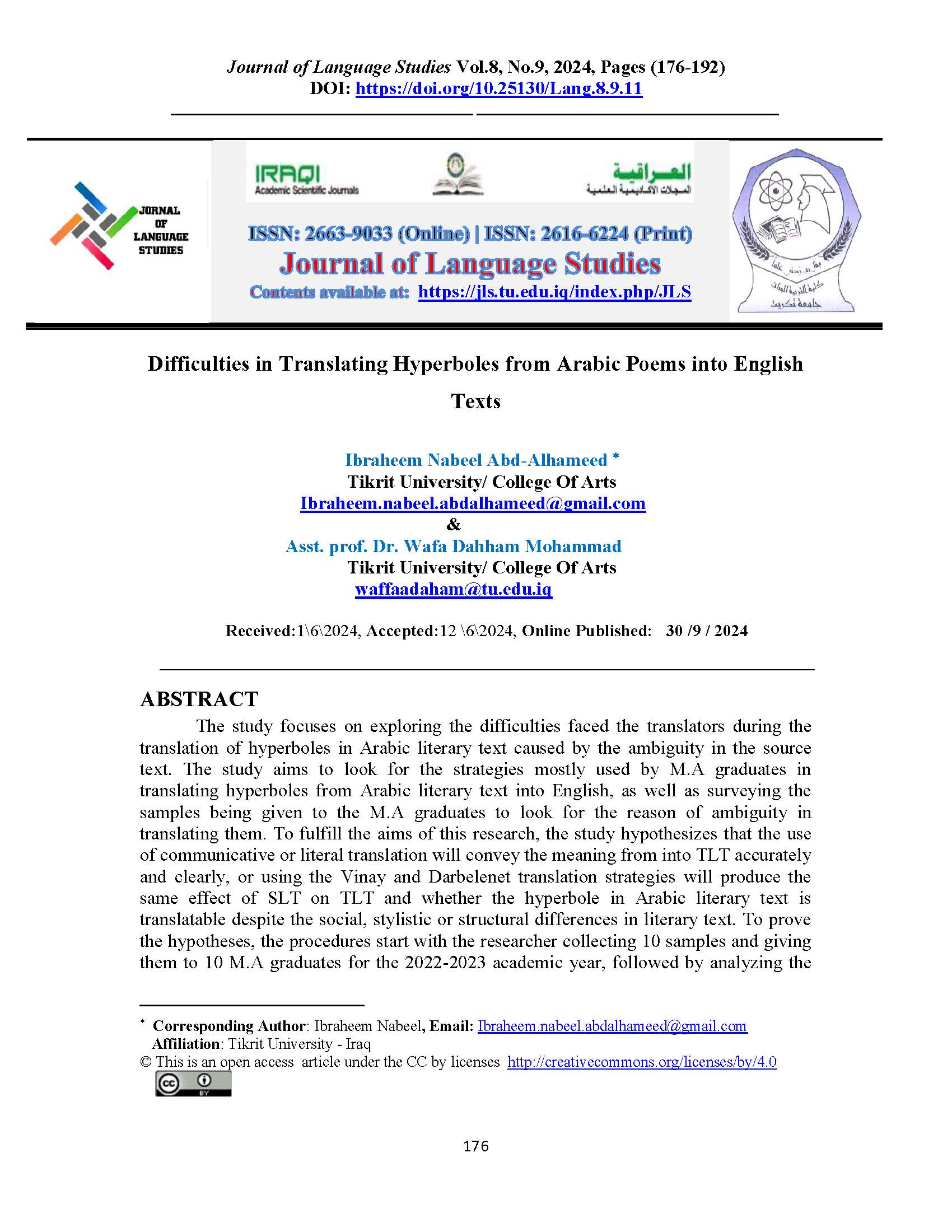Difficulties in Translating Hyperboles from Arabic Poems into English Texts
DOI:
https://doi.org/10.25130/Lang.8.9.11Keywords:
Difficulties, Hyperboles, TranslationAbstract
The study focuses on exploring the difficulties faced the translators during the translation of hyperboles in Arabic literary text caused by the ambiguity in the source text. The study aims to look for the strategies mostly used by M.A graduates in translating hyperboles from Arabic literary text into English, as well as surveying the samples being given to the M.A graduates to look for the reason of ambiguity in translating them. To fulfill the aims of this research, the study hypothesizes that the use of communicative or literal translation will convey the meaning from into TLT accurately and clearly, or using the Vinay and Darbelenet translation strategies will produce the same effect of SLT on TLT and whether the hyperbole in Arabic literary text is translatable despite the social, stylistic or structural differences in literary text. To prove the hypotheses, the procedures start with the researcher collecting 10 samples and giving them to 10 M.A graduates for the 2022-2023 academic year, followed by analyzing the samples according to the Vinay and Darbelenet translation model, the samples were chosen from the poem collection of Badr Shakir Al-Sayyab “Rain Song””انشودة المطر”, specifically from the two poems “قافلة الضياع” and “غريب على الخليج”, and given to be translated into English by the M.A graduates, then discussing the results of the collected data. The study concludes that the translation of hyperboles from Arabic literary texts into English text can be challenging due to the different ways they are used, additionally hyperboles can have multiple interpretations which is the result of the context they are used in, as well as that hyperboles in Arabic literary text are also affected by the difference in culture and social background and other factors.
References
Aristotle.(1976). Ethics. New York: Penguin.
Burgers, C., Brugman, B. C., Lavalette, K. Y., & Steen, G. J. (2016). HIP: A Method for Linguistic Hyperbole Identification in Discourse. Metaphor and Symbol, 31(3), 163 178.doi:10.1080/10926488.2016.1187041.
Burgers, C., Van Mulken, M., & Schellens, P. J. (2011). Finding irony: An introduction of the Verbal Irony Procedure (VIP). Metaphor and Symbol, 26(3), 186–205. doi:10.1080/10926488.2011.583194
Cano Mora, L. (2009). All or nothing: a semantic analysis of hyperbole. Revista de Lingüística y Lenguas Aplicadas, 4(1):25–35.
Carston, R., & Wearing, C. (2015). Hyperbolic language and its relation to metaphor and irony. Journal of Pragmatics,79, 79-92. doi: 10.1016/j.pragma. 2015.01.011
Claridge, C. (2010). Hyperbole in English: a corpus-based study of exaggeration. Cambridge, UK: Cambridge University Press.Carston, R., & Wearing, C. (2015). Hyperbolic language and its relation to metaphor and irony. Journal of Pragmatics,79, 79-92. doi: 10.1016/j.pragma. 2015.01.011.
Clark, H. H. (1996). Using language. Cambridge: Cambridge University Press.
Cohen, D. (1987). Educational technology, policy, and practice. Educational Evaluation and Policy Analysis, 9, 153-170.
Colston, H. L., & Gibbs, R. W. (2002). Are Irony and Metaphor Understood Differently? Metaphor and Symbol,17(1), 57-80. doi: 10.1207/s15327868ms17015.
Colston, H. L., & O’brien, J. (2000). Contrast of Kind Versus Contrast of Magnitude: The Pragmatic Accomplishments of Irony and Hyperbole. Discourse Processes, 30(2), 179-199. doi:10.1207/s15326950dp300205.Crystal, D. (1991). Dictionary of Linguistics and Phonetics. (3rd edition). Cambridge, M.A. Basil Blackwell.
Edleman, Robert et al. (1989). "Self-reported Expressions of Embarrassment in five European Cultures". Journal of Cross-Cultural Psychology, 20, 357-371.
Ghazala, H. (1995). Translation as Problem and Solutions. University of Syria. Dar El –Kalam AL-Arabi. Quarterly.
Happé, F. G. (1993). Communicative competence and theory of mind in autism: A test of relevance theory. Cognition,48(2), 101-119. doi:10.1016/0010- 0277(93)90026-r.
Herbert Colston et al. You'll never believe this: irony and hyperbole in expressing surprise. Journal of Psycholinguistic Research(1998).
Leech, G. (1983). Principles of pragmatics. London: Longman.
McCarthy, M., & Carter, R. (2004). “Theres millions of them”: hyperbole in everyday conversation. Journal of Pragmatics,36(2),149 184.doi:10.1016/s03782166(03)00116-4..
Norasetkosol, S., Timyam, N., & Sriussadaporn, N. (2012). Persuasive linguistic devices in travel magazines.
Ohlrogge, A and Tsang,J. (2004). Hyperbole in Academic and Research Speech? Kibbitzer#3.
Recchia, H. E., Howe, N., Ross, H. S., & Alexander, S. (2010). Children’s understanding and production of verbal irony in family conversations. British Journal of Developmental Psychology,28(2), 255-274. doi:10.1348/ - 026151008x401903.
Sperber, D., & Wilson, D. (2012). A deflationary account of metaphors. In D. Wilson & D. Sperber (Authors), Meaning and Relevance (pp. 97-122). Cambridge: Cambridge University Press.doi:10.1017/CBO9781139028370.007.
Spitzbardt, H. 1963. “Overstatement and Understatement in British and American English”. Philologica Pragensia. 6: 45. 277-286.
Steen, G. J., Dorst, A. G., Herrmann, J. B., Kaal, A., Krennmayr, T., & Pasma, T. (2010a). A method for linguistic metaphor identification: From MIP to MIPVU. Amsterdam, The Netherlands: Benjamins.
Stern, J. (2000). Metaphor in Context. London: MIT Press.
Vinay, J. & Darbelnet, J. (1995). Comparative Stylistics of French and English: A Methodology for Translation. John Benjamins Publishing.
Yowelly and Lataiwish (2000). Principles of Translation. Renghaziy: Dar Annahda Alarabia.
Zeydan Khalaf Omar l, Abed Shahooth Khalaf (2009, p.p.66,67) A Sociolinguistic Study of Hyperbole. Journal of Anbar University of Language and Literature(Ver.1).

